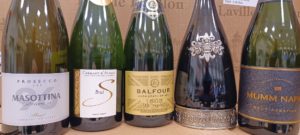It’s all about Champagne and Sparkling Wine…
I’ll give you a brief overview of the different bubbles, and where they come from. I’m talking Champagne, Cava, Prosecco, Bubbles from the USA and more. The different ways to get bubbles in the bottle, or how champagne is made.
The Magic Flute
“Flute”-shaped glasses best trap aromas and conduct coolness in sparkling wine, which allows for a steadier stream of bubbles to be released from the bottom of the glass. Bowl-shaped champagne glasses warm up wine too quickly and cause bubbles to dissipate faster. Due to their slick bottoms wine glasses don’t show the bubbles (“bead”) structure and make sparkling wine look flatter, although the bubbles are still present.The Big Chill
Most of us like to serve sparkling wine a little colder than white wine, but the colder it is the more inhibited the flavors. A good rule of thumb for chilling sparkling wine is 20 to 30 minutes in a half-water-half-ice bath or three hours in the refrigerator. When the sparkling wine warms a little you’ll notice more flavor.Big Bang Theory
Always open sparkling wine after it’s been chilled. If you open a sparkling when it’s not chilled you’ll have a far more volatile bottle with a much bigger bang. The pressure can be so great that if you loosen the wire hood the cork is likely to pop on its own accord. Bubbles in a chilled bottle of sparkling wine are more soluble, which lessens the pressure within the bottle, which makes serving much easier.Glass Act
No need to ice sparkling wine glasses. During your first pour the mousse (foam) will rise to the top of your glass and chill it for you, which results in less mousse on the second pour. For the best bubble viewing you should also make sure the glass is extremely clean.Palate Prep
If you want to do more serious wine tasting, don’t drink strong coffee or eat dishes with a lot of garlic or hot spice beforehand because it will influence your palate.Timely Tastebuds
Many wine tasters feel the palate is the keenest earlier in the day, which allows for better tasting ability.
Skip the Swirl
No need to swirl a sparkling wine. Its natural carbonation (bubbles) magnifies and releases the aromas and flavor.
The Bead Goes On
You can tell a sparkling wine has been made under the guidelines of méthode traditionnelle (bottle aging) by its bubbles. Big, random bubbles resembling soda are indications of a sparkler that has not been bottle aged. Tiny bubbles in a strand-like formation are associated with bottle-aged sparkling wine.
Crisp & Clean
Sparkling wine’s carbonation and acidity have crisp palate-cleansing qualities. Its bubbles make delicate flavors come to life on the palate. With the help of sparkling wine’s acidity the bubbles lift creamy, salty rich foods off the palate, leaving it refreshed. Sparkling wine’s automatic cleansing qualities come in handy when tasting various sparkling wines since you won’t need to neutralize your palate between tastes.
Dare to Pair
Try sparkling wine with meals. The pop of the cork announces fun, the cleansing characteristics enliven your palate, and pairing versatility makes sparkling wine a great partner for a variety of foods ranging from spicy, salty foods and rich fare to sweet finales.
How to Saber a bottle of bubbles…

